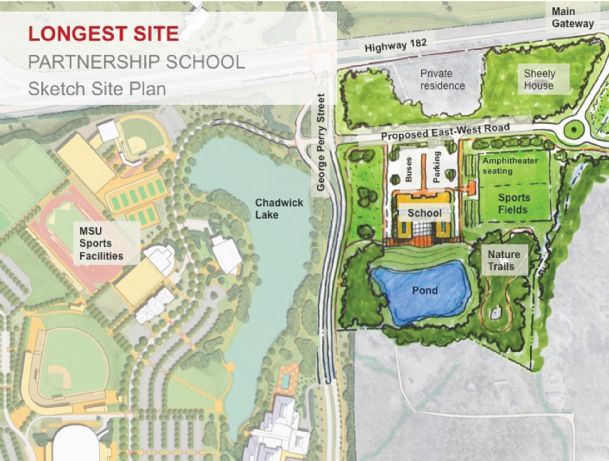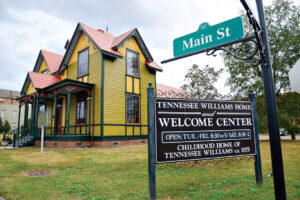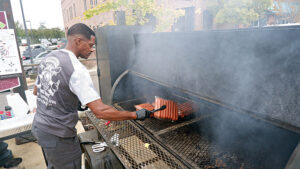A school that costs $30 million shouldn’t have walls, according to Mississippi State University professor Devon Brenner.
Brenner, head of curriculum, instruction and education in the MSU College of Education, has weaved this vision into a plan for a proposed demonstration school on the university’s campus that would house Starkville-Oktibbeha Consolidated School District sixth- and seventh-graders. Starkville and Oktibbeha County school districts will consolidate on July 1, and the demonstration school is intended to house all the district’s 6-7 students — whether city or county — which right now would range between 900 and 1,000 students.
Sure, the school’s building would have physical walls, but Brenner said the technology it would contain, combined with enhanced teacher education and research opportunities it would provide, the school could break down educational barriers in classrooms all over Mississippi. This school would accomplish this widespread impact, Brenner said, by providing education for consolidated school district students in an “equitable, fair, innovative and progressive way.”
The school will also provide more intensive field experience under one roof for MSU students seeking degrees in both elementary (which covers K-6) and secondary (7-12) education.
“If this works as designed, it will serve the entire state,” Brenner said. “There is support at MSU, from the top down, as well as from the school district to create something in the community that is powerful and unique…it will strengthen our presence in the consolidated school district and it will provide a calmer, safer, more engaging environment for students to participate in cutting-edge instruction.”
■■■
Brenner said she envisions the school being a laboratory for education in many facets, starting with the children and moving all the way up to tenured professors. Teacher education students, she said, would serve as interns and aides in classrooms, as well as offer them other intensive field experience opportunities on campus. Brenner hopes to have her department — now in Allen Hall — relocated to the demonstration school, which would give consolidated school district teachers in the school and MSU professors easy access to each other. That relationship would create opportunities for research collaborations, co-teaching and more effective studies on best practices.
“Think about it: a teacher will have an expert in that field right down the hall who can help them develop strategies for instructing a special needs student, dealing with a behavioral problem or planning an engaging lesson,” Brenner said. “It could also create opportunities for teacher exchanges, meaning a professor might have an opportunity to teach a lesson in a sixth- or seventh-grade classroom one day, and the teacher might go into the professor’s classroom and share his or her professional experiences.”
Also, having more adults on a grade 6-7 campus, Brenner said — whether it be MSU faculty and students or school district employees — would enhance mentorship potential and, at the very least, help better monitor hallways.
Beyond those hallways, the audio and video technology planned for the site would allow teachers to share lessons remotely with schools across the state in real time.
Furthering the school’s research function is a planned Center for Rural Education that would focus on issues Brenner said were more prevalent in rural southern schools, such as consolidation, poverty, race relations and lack of access to resources. That center, Brenner said, would also research ways to alleviate chronic teacher shortages in Mississippi’s rural communities, particularly in math, foreign language, science and special education.
“Part of the problem is turnover,” Brenner said. “So how can we better support teachers in rural communities, and how can we help those communities grow their own teachers?”
■■■
SSD Superintendent Lewis Holloway, who will also lead administration for the consolidated school district, said 100 MSU students are completing internships or research at Starkville campuses, and that number would triple with the demonstration school in place. Also, he said the demonstration school product would put “better and more” instructional material in front of students at a critical age, which would translate into better test scores.
“Sixth grade is the most critical year we have,” Holloway said. “We do fine with them through fifth grade, but they turn into something else when they get to sixth grade. In this environment, we increase the likelihood of keeping them engaged.”
From the teaching aspect, Holloway said he wants to put the district’s best foot forward at the demonstration school in a way that helps teachers at other district campuses and sets a good example for future educators.
“We want our teachers in this school to be the best of the best,” he said. “We want juniors and seniors at MSU who are about to graduate and go into the education field to see, from our people, what effective instruction looks like.”
■■■
MSU has donated 43 acres for the school site at the southeast corner of Highway 182 and the Thad Cochran Research, Technology and Economic Development Park. Per preliminary designs, the site would have access to a pond, walking trails and athletic facilities, and it would be located on the campus of Mississippi’s largest university, where students will be walking-distance from facilities, field trips and event opportunities that could further enhance their school experience.
Brenner believes immersing students in engaging classroom environments inside the building, and exposing them to what MSU has to offer outside, will incentivize more students to seek a post-secondary education once they graduate from high school.
Preliminary design plans call for a 102,000 square-foot split-level school divided into wings, each with a “pod” or common area connecting eight classrooms in four subject areas — English, math, science and social studies. Each pod would have observation windows for MSU students and faculty to see instruction without disrupting the classroom.
In a “perfect world,” Brenner hopes the school is housing students by 2018, but fully funding the project is no guarantee.
■■■
MSU has dedicated $10 million toward the project, including $5 million in land value and a commitment to raise another $5 million through private donations. The district-university partnership hopes to get another $10 million through a state legislative appropriation that has not yet come to fruition and hopes to get the remaining $10 million from a bond issue that would raise property taxes for citizens specifically living in county school district territory.
The bond, estimated at $13.2 million, would also fund renovations at East and West Oktibbeha elementary schools — where county students will continue to attend through fifth grade — and bolster the county school bus system. East and West Oktibbeha high schools, which now house grades 7-12, will close and all of those students will attend class in Starkville after consolidation.
The legislature mandated the districts consolidate in 2013, due in part to academic and facilities deficiencies within OCSD, which has been under state conservatorship since 2012. Legislators last year approved a plan from a seven-member commission consisting of school officials, parents, MSU and Mississippi Department of Education, that included the renovations and the demonstration school, and cleared OCSD to seek a reverse referendum for the bond so that it could raise the money without voter approval. Oktibbeha County citizens have since produced a petition to place the bond issue before the voters, but the petition has yet to be certified.
Holloway said the bonds were a way for county taxpayers to have “skin in the game” with consolidation. He said SSD would already provide middle school and high school facilities for all the district’s students and city residents pay more than 65 mills in property taxes, compared to 52 mills in the county. The bond would raise the county millage by at least 10.
If the bond makes it to the ballot, it will require 60-percent voter approval to pass, a feat Holloway considers impossible, given county voters track record for never approving a school bond issue. That would not only devastate the demonstration school plan, he said, it would burden the consolidated school district with finding an alternate way to deal with overcrowding at Armstrong Middle School, which now houses grades 6-8.
With the demonstration school in place, Holloway said AMS could convert to an 8-9 campus and Starkville High School could house grades 10-12.
“If we don’t get this bond issue, I don’t see how this happens,” Holloway said. “If this is defeated, the demonstration school goes away. Also, then we’re talking about bringing in trailers to Armstrong or expanding it somehow, and there’s not going to be a financial way to do that. Our enrollment is growing by about 2 percent a year, and having grades 8 and 9 at Armstrong gives us the capacity to grow.”
Brenner said the bond issue failing would deal a painful blow to a plan that has unmeasured potential, whether through downsizing the design or limiting the program’s scope.
“The children across the county deserve better,” Brenner said. “It’s time to do right by these kids. As we consolidate, we really need to be one district. Although this is an investment, it’s a cost effective way long-term to bring together the resources of the university and school district. If we don’t do this now, we’ll have to do it eventually. The longer we wait, the more it will cost, and in the meantime, how much will it cost in human capital?”
Zack Plair is the managing editor for The Dispatch.
You can help your community
Quality, in-depth journalism is essential to a healthy community. The Dispatch brings you the most complete reporting and insightful commentary in the Golden Triangle, but we need your help to continue our efforts. In the past week, our reporters have posted 51 articles to cdispatch.com. Please consider subscribing to our website for only $2.30 per week to help support local journalism and our community.







